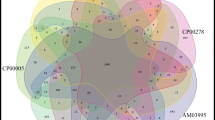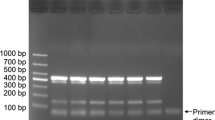Abstract.
Pierce's disease (PD, Xylella fastidiosa) of grapevine is the primary pathogen limiting vinifera grape production in Florida and other regions of the southeastern United States. Quick and accurate detection of PD strains is essential for PD studies and control. A unique random amplified polymorphic DNA (PD1-1-2) was isolated from a PD strain from Florida. Fragment PD1-1-2 was cloned, sequenced, and found to be 1005 bp in length. PCR primers were designed to utilize these sequence data for PD strain detection. One primer set (XF176f–XF954r) amplified a 779-bp DNA fragment from 34 PD strains including seven pathotypes of X. fastidiosa, but not from strains of Xanthomonas campestris pv. campestris, Xan. vesicatoria or Escherichia coli. A second primer set (XF176f and XF686r) amplified a 511-bp fragment specific to 98 PD strains, but not from strains of citrus variegated chlorosis, mulberry leaf scorch, oak leaf scorch, periwinkle wilt, phony peach, or plum leaf scald. Sequence analysis indicated that RAPD fragment PD1-1-2 contains a Ser-tRNA gene. The PD-specific region includes a TaqI restriction site (TCGA) and is 150 bp downstream of the Ser-tRNA gene.
Similar content being viewed by others
Author information
Authors and Affiliations
Additional information
Received: 1 March 1999 / Accepted: 5 April 1999
Rights and permissions
About this article
Cite this article
Banks, D., Albibi, R., Chen, J. et al. Specific Detection of Xylella fastidiosa Pierce's Disease Strains. Curr Microbiol 39, 85–88 (1999). https://doi.org/10.1007/s002849900423
Issue Date:
DOI: https://doi.org/10.1007/s002849900423




